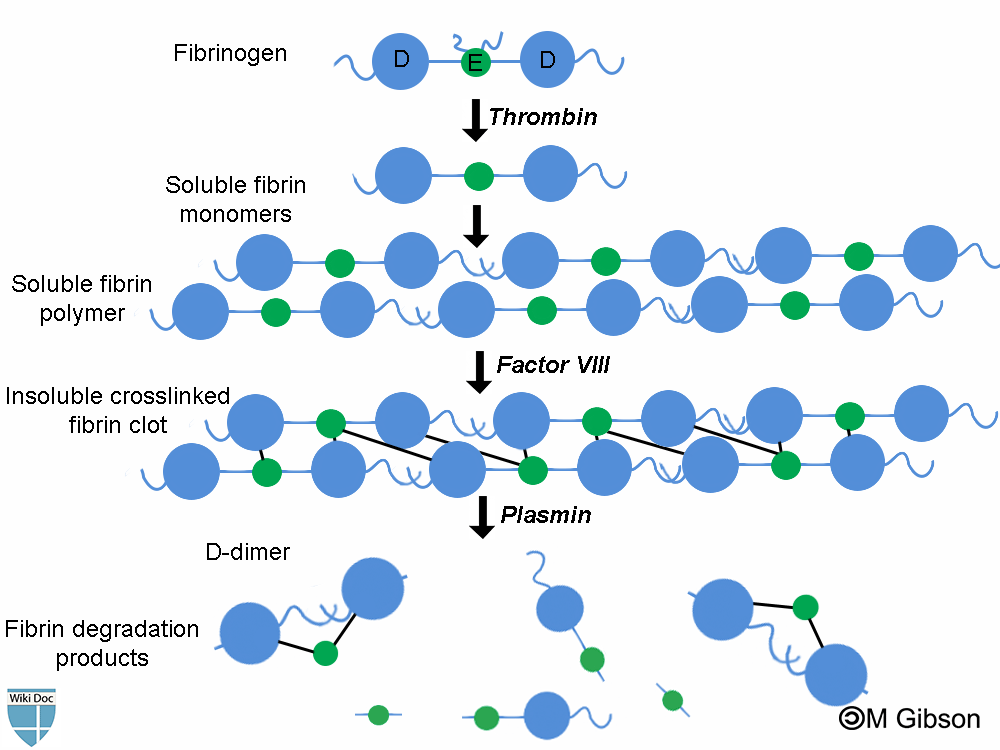D-dimer physiology: Difference between revisions
Rim Halaby (talk | contribs) (Created page with "__NOTOC__ {{D-dimer}} {{CMG}} ==Overview== ==References== {{Reflist|2}} Category:Laboratory Test Category:Chemical pathology Category:Hematology Category:Fibr...") |
Rim Halaby (talk | contribs) No edit summary |
||
| Line 4: | Line 4: | ||
==Overview== | ==Overview== | ||
==Physiology== | |||
[[Fibrin degradation product]]s (FDPs) are formed whenever [[fibrin]] is [[proteolysis|broken down]] by [[enzyme]]s. In fact, FDP are formed as a result of the sequential actions of the following three different enzymes: [[thrombin]], [[factor VIII]] and [[plasmin]]. Determining FDPs is not considered useful, as this does not indicate whether the fibrin is part of a blood clot (or being generated as part of [[inflammation]]). | |||
D-dimers are unique in that they are the breakdown products of a fibrin mesh that has been stabilized by [[Factor XIII]]. This factor crosslinks the E-element to ''two'' D-elements. This is the final step in the generation of a thrombus. | |||
[[Plasmin]] is a [[fibrinolysis|fibrinolytic]] enzyme that organizes clots and breaks down the fibrin mesh. It cannot, however, break down the bonds between one E and two D units. The protein fragment thus left over is a D-dimer.<ref name="pmid19008457">{{cite journal| author=Adam SS, Key NS, Greenberg CS| title=D-dimer antigen: current concepts and future prospects. | journal=Blood | year= 2009 | volume= 113 | issue= 13 | pages= 2878-87 | pmid=19008457 | doi=10.1182/blood-2008-06-165845 | pmc= | url=http://www.ncbi.nlm.nih.gov/entrez/eutils/elink.fcgi?dbfrom=pubmed&tool=sumsearch.org/cite&retmode=ref&cmd=prlinks&id=19008457 }} </ref> | |||
Shown below is an image summarizing the formation of D-dimers and other [[fibrin degradation product]]s as a result of the sequential action of the three enzymes: [[thrombin]], [[factor VIII]] and [[plasmin]]. | |||
[[Image:D-dimer-formation.gif|500px|left|Formation of D-dimer]] | |||
<br clear="left"/> | |||
==References== | ==References== | ||
Revision as of 13:37, 25 September 2013
|
D-Dimer Microchapters |
|
Clinical Correlation |
|---|
|
Clinical Trials |
|
D-dimer physiology On the Web |
|
American Roentgen Ray Society Images of D-dimer physiology |
Editor-In-Chief: C. Michael Gibson, M.S., M.D. [1]
Overview
Physiology
Fibrin degradation products (FDPs) are formed whenever fibrin is broken down by enzymes. In fact, FDP are formed as a result of the sequential actions of the following three different enzymes: thrombin, factor VIII and plasmin. Determining FDPs is not considered useful, as this does not indicate whether the fibrin is part of a blood clot (or being generated as part of inflammation).
D-dimers are unique in that they are the breakdown products of a fibrin mesh that has been stabilized by Factor XIII. This factor crosslinks the E-element to two D-elements. This is the final step in the generation of a thrombus.
Plasmin is a fibrinolytic enzyme that organizes clots and breaks down the fibrin mesh. It cannot, however, break down the bonds between one E and two D units. The protein fragment thus left over is a D-dimer.[1]
Shown below is an image summarizing the formation of D-dimers and other fibrin degradation products as a result of the sequential action of the three enzymes: thrombin, factor VIII and plasmin.

References
- ↑ Adam SS, Key NS, Greenberg CS (2009). "D-dimer antigen: current concepts and future prospects". Blood. 113 (13): 2878–87. doi:10.1182/blood-2008-06-165845. PMID 19008457 Check
|pmid=value (help).